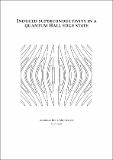Files in this item
Induced superconductivity in a quantum Hall edge state
Item metadata
| dc.contributor.advisor | Braunecker, Bernd | |
| dc.contributor.advisor | Schmidt, Thomas L. | |
| dc.contributor.author | Michelsen, Andreas Nicolai Bock | |
| dc.coverage.spatial | 137 | en_US |
| dc.date.accessioned | 2023-02-06T10:37:19Z | |
| dc.date.available | 2023-02-06T10:37:19Z | |
| dc.date.issued | 2023-06-12 | |
| dc.identifier.uri | https://hdl.handle.net/10023/26907 | |
| dc.description.abstract | In the search for non-Abelian anyonic zero modes for inherently fault-tolerant quantum computing, the hybridized superconductor - quantum Hall edge system plays an important role. Inspired by recent experimental realizations of this system, we describe it through a microscopic theory based on a BCS superconductor with Rashba spin-orbit coupling and Meissner effect at the surface, which is tunnel-coupled to a spin-polarized integer or fractional quantum Hall edge. By integrating out the superconductor, we arrive at an effective theory of the proximitized edge state and establish a qualitative description of the induced superconductivity. We predict analytical relations between experimentally available parameters and the key parameters of the induced superconductivity, as well as the experimentally relevant transport signatures. Extending the model to the fractional quantum Hall case, we find that both the spin-orbit coupling and the Meissner effect play central roles. The former allows for transport across the interface, while the latter controls the topological phase transition of the induced p-wave pairing in the edge state, allows for particle-hole conversion in transport for weak induced pairing amplitudes, and determines when pairing dominates over fractionalization in the proximitized fractional quantum Hall edge. Further experimental indicators are predicted for the system of a superconductor coupled through a quantum point contact with an integer or fractional quantum Hall edge, with a Pauli blockade which is robust to interactions and fractionalization as a key indicator of induced superconductivity. With these predictions we establish a more solid qualitative understanding of this important system, and advance the field towards the realization of anyonic zero modes. | en_US |
| dc.language.iso | en | en_US |
| dc.subject | Andreev reflection | en_US |
| dc.subject | Superconductivity | en_US |
| dc.subject | Quantum Hall effect | en_US |
| dc.subject | Fractional quantum Hall effect | en_US |
| dc.title | Induced superconductivity in a quantum Hall edge state | en_US |
| dc.type | Thesis | en_US |
| dc.contributor.sponsor | Fonds national de la recherche Luxembourg | en_US |
| dc.contributor.sponsor | University of St Andrews. St Leonard's College European Inter-University Doctoral Scholarship | en_US |
| dc.type.qualificationlevel | Doctoral | en_US |
| dc.type.qualificationname | PhD Doctor of Philosophy | en_US |
| dc.publisher.institution | The University of St Andrews | en_US |
| dc.publisher.department | University of Luxembourg | en_US |
| dc.identifier.doi | https://doi.org/10.17630/sta/262 | |
| dc.identifier.grantnumber | ATTRACT A14/MS/7556175/MoMeSys | en_US |
This item appears in the following Collection(s)
Items in the St Andrews Research Repository are protected by copyright, with all rights reserved, unless otherwise indicated.

